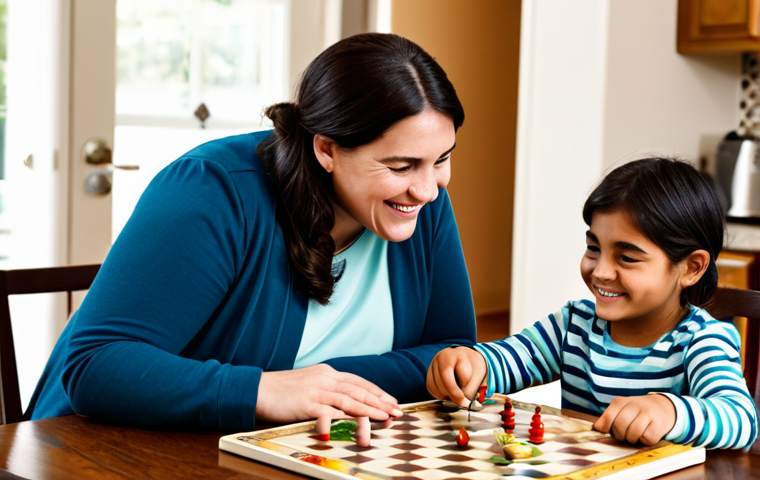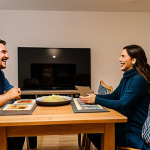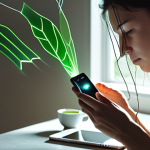I remember a time, not so long ago, when my smartphone felt like an extension of my arm, constantly buzzing, pulling me away from actual conversations, real sunsets, and even my own thoughts.
It’s a familiar story for many of us, isn’t it? The sheer volume of digital noise and the relentless ping of notifications have, for too long, overshadowed our capacity for genuine connection and deep focus, eroding our mental well-being one scroll at a time.
With the rapid acceleration of AI-powered features and the metaverse blurring the lines of reality, understanding how to consciously engage with our devices—rather than being passively consumed by them—has never been more critical.
It’s not about abandoning technology; it’s about mastering it, teaching ourselves and especially the younger generations the essential skill of digital literacy and thoughtful disconnection.
My own journey, which involved consciously setting boundaries and exploring mindful tech usage, truly transformed how I interact with the world around me.
This isn’t just a fleeting trend; it’s a vital life skill for navigating our increasingly hyper-connected future. Let’s get into the specifics.
The Art of Intentional Disconnection: Reclaiming Your Mental Space

It feels like just yesterday I was a prisoner of my own phone, tethered to every notification, every fleeting news update, every “like” that promised a momentary hit of dopamine.
I remember the subtle anxiety that would gnaw at me if I left my phone in another room, or the frantic scramble to check emails even during a lovely walk in the park.
This isn’t just about reducing screen time; it’s about actively choosing to engage with life beyond the glow of a screen. For me, this journey began with a single, simple realization: my device was controlling me, not the other way around.
It’s a profound shift, moving from passive consumption to active curation of your digital life. This isn’t about shaming anyone; it’s about empowerment.
It’s about recognizing that our attention is a finite resource, and allowing it to be constantly fragmented by digital demands leaves us feeling depleted, not enriched.
My personal experience taught me that true freedom comes from mastering your tech, not being enslaved by it. It requires an honest look at our habits and a willingness to embrace discomfort initially, knowing the long-term gains in peace and presence are immeasurable.
1. Identifying Your Digital Triggers and Addiction Patterns
Honestly, the first step felt a bit like therapy: acknowledging the problem. For me, it was the “fear of missing out” (FOMO) and the constant need for validation from social media.
I’d pick up my phone instinctively, even when I had no reason to, just to scroll. That mindless scrolling was the biggest culprit, robbing me of hours I could have spent reading, creating, or simply being present with my family.
I started noticing how certain emotions – boredom, stress, even excitement – would immediately lead me to my phone. It’s a classic conditioned response, isn’t it?
Understanding *what* pulls you in and *why* is incredibly powerful. Are you reaching for your phone when you’re feeling lonely, or when you need a distraction from a difficult task?
Recognizing these patterns is the bedrock of building new, healthier habits. It’s a deeply personal excavation of your digital self, and it’s absolutely vital for sustainable change.
2. Crafting a Personalized Digital Detox Plan: Beyond Just Turning it Off
A full-on digital detox might sound daunting, or even impossible, especially if your work relies on connectivity. But it’s not about abandoning technology; it’s about strategic withdrawal and mindful re-engagement.
When I first tried this, I didn’t just switch off everything; I started by setting “no-phone zones” in my home, like the dining table and bedroom. Then, I implemented “tech-free hours” in the evenings.
It was tough initially, I won’t lie. My hand would automatically reach for my pocket, feeling for the familiar weight. But soon, I noticed the quiet emerging, the conversations flowing more freely, and my sleep improving dramatically.
It’s about building a fortress of focus around your most valuable hours and relationships. What works for one person might not work for another, so be kind to yourself and experiment.
This plan isn’t a rigid set of rules; it’s a flexible framework designed to support your unique needs and aspirations for a more balanced life.
Building Digital Resilience: The Long-Term Play
You know, it’s not enough to just put the phone down once in a while. True digital well-being is about building an ongoing resilience, a kind of mental armor against the incessant pings and pulls of the online world.
It’s about training your brain to choose focus over distraction, connection over comparison, and real life over curated feeds. I’ve come to see it as a muscle that needs regular exercise.
Just like you wouldn’t expect to run a marathon after one jog, you can’t expect a complete overhaul of your digital habits overnight. It’s a continuous process of learning, adapting, and reinforcing positive behaviors.
This journey has given me a profound sense of control over my attention, which, in our hyper-connected world, feels like the ultimate superpower. It’s about being proactive rather than reactive, about designing your digital environment to serve your goals, rather than allowing it to dictate them.
1. Establishing Healthy Digital Boundaries and Habits
This was a game-changer for me. It wasn’t about deprivation, but about intentional design. I turned off most notifications, leaving only essential calls and texts.
My phone’s screen went grayscale for a while, making it less visually stimulating – trust me, those vibrant app icons are designed to hook you! I started leaving my phone outside my bedroom at night.
I even bought an actual alarm clock! It sounds small, but these micro-habits add up. I scheduled specific times to check emails and social media, rather than letting them interrupt my flow throughout the day.
It’s like creating a digital “office hours” for yourself. This isn’t about being anti-technology; it’s about being pro-yourself. It helped me reclaim my mornings, which used to be swallowed by news feeds, and instead dedicate them to personal growth or quiet reflection.
2. The Power of Intentional Engagement and Mindful Consumption
We’re surrounded by an endless stream of information, and it’s easy to get lost. I learned to ask myself: “Why am I opening this app? What do I hope to gain from this interaction?” Before mindlessly scrolling on Instagram, I now consciously think, “Am I looking for inspiration?
To connect with a friend? Or just to kill time?” If it’s the latter, I often choose a different activity. This intentionality extends to what content I consume too.
I actively curate my feeds, unfollowing accounts that trigger negative emotions or add no value, and following those that inspire, educate, or uplift me.
It’s about treating your digital diet like your physical diet: what you consume impacts how you feel. I remember actively seeking out online communities focused on positive mental health and productivity, shifting my focus from passive scrolling to active learning and growth.
Navigating the AI Frontier: Smart Tech Engagement
With AI integrating into every facet of our digital lives, from personalized recommendations to generative content, our relationship with technology is becoming even more complex.
It’s no longer just about managing screen time; it’s about understanding the algorithms, discerning AI-generated content from human, and leveraging these powerful tools responsibly.
I’ve personally experimented with AI tools for productivity, and while they are incredible, they also highlighted the subtle ways our critical thinking can be outsourced if we’re not careful.
This isn’t a call to fear AI, but rather to embrace it with open eyes and a clear strategy for maintaining our human essence and cognitive autonomy. The future of digital wellness hinges on our ability to not just use technology, but to truly *master* it.
1. Understanding AI’s Influence on Our Digital Habits
When AI starts suggesting what to watch, what to read, and even what to think, it’s easy to fall into a passive consumption trap. I noticed how my social media feeds, heavily influenced by AI algorithms, would create echo chambers, showing me more of what I already agreed with or had previously engaged with.
It’s comfortable, but it limits exposure to new ideas and perspectives. Understanding that these algorithms are designed to maximize engagement – often at the expense of our time and mental well-being – is crucial.
I started actively seeking out diverse viewpoints and intentionally breaking out of my algorithmic bubble. It required a conscious effort, but the mental expansion was incredibly rewarding.
2. Leveraging AI for Good: Enhancing, Not Replacing, Human Connection
AI has immense potential to enhance our lives, if we use it wisely. For instance, I’ve used AI-powered tools to summarize long articles, freeing up time to engage in deeper conversations or creative pursuits.
I’ve seen how smart home devices can streamline routines, giving me more time for offline activities. The trick is to use AI as a *tool* to amplify human potential, not to replace genuine human connection or critical thinking.
Think of it as a powerful assistant, not a substitute for your own agency. The goal is to offload mundane tasks to AI so you can invest more energy into what truly matters: meaningful relationships, personal growth, and real-world experiences.
Empowering the Next Generation: Parenting in the Digital Age
As a parent, navigating the digital world with my kids feels like walking a tightrope. On one hand, I want them to be digitally literate and prepared for a tech-driven future.
On the other, I see the struggles of my own generation with digital overload and want to protect them from falling into the same traps. It’s a constant balancing act, demanding patience, consistency, and a willingness to learn alongside them.
This isn’t just about setting screen limits; it’s about instilling a profound understanding of responsible digital citizenship and fostering critical thinking from a young age.
My approach has always been one of collaboration and open dialogue, rather than strict enforcement, because I believe true understanding comes from within.
1. Fostering Critical Thinking and Digital Literacy in Children
It’s not enough to tell kids “don’t look at that.” We need to teach them *why*. I’ve had countless conversations with my children about identifying misinformation, understanding online privacy, and recognizing the persuasive tactics used by apps and social media.
We discuss what they see online, how it makes them feel, and the difference between curated online personas and real life. This isn’t a one-time lecture; it’s an ongoing dialogue.
We explore questions like, “Who created this content? Why? What might their agenda be?” This empowers them to be discerning digital citizens, rather than passive consumers.
It’s about giving them the tools to navigate the vast digital landscape safely and intelligently.
2. Setting Age-Appropriate Boundaries and Leading by Example
This is where the rubber meets the road, and honestly, it’s tough. We started by having clear “device-free” times and zones – no phones at dinner, no tablets in bedrooms after a certain hour.
But the most impactful thing I did was lead by example. If I’m telling my kids to put their phones away, I need to do the same. They’re watching everything we do.
It’s a constant self-check, because kids pick up on hypocrisy immediately. We also co-create their digital rules, giving them agency in the process, which encourages greater compliance.
It’s not about being perfect, but about being consistent and open to adapting as they grow.
| Aspect of Digital Wellness | Old Habits (Pre-Mindful Tech) | New Habits (Post-Mindful Tech) |
|---|---|---|
| Daily Device Use | Constant checking, first thing in AM, last thing at night. | Scheduled checks, device-free mornings & evenings. |
| Notification Management | All notifications on, constant interruptions. | Most notifications off, only essential alerts. |
| Screen Time Impact | Poor sleep, increased anxiety, fragmented attention. | Improved sleep, reduced anxiety, enhanced focus. |
| Content Consumption | Mindless scrolling, passive absorption of feeds. | Intentional engagement, active curation, diverse sources. |
| Human Connection | Distracted during in-person interactions, reliance on digital. | More present in conversations, prioritized real-world bonds. |
Building Your Digital Wellness Toolkit: Practical Steps for a Balanced Life
After years of grappling with digital overwhelm, I’ve collected a set of practical tools and strategies that truly make a difference. This isn’t about being a digital minimalist, but about being a digital *intentionalist*.
It’s about arming yourself with the right resources to prevent tech from taking over your life, allowing it to be a supportive tool rather than a demanding master.
I’ve experimented with various apps, physical tools, and mindset shifts, and what I’ve found is that consistency and adapting these tools to your personal rhythm are key.
There’s no one-size-fits-all solution, but a combination of these elements can significantly enhance your digital well-being.
1. Utilizing Tech to Disconnect: Apps and Features That Help
It might sound counterintuitive, but some apps are actually designed to help you *reduce* screen time. I’ve personally found “Focus Mode” or “Digital Wellbeing” features on smartphones incredibly helpful, allowing me to pause notifications and limit app usage during work or family time.
Screen time trackers are also fantastic for building awareness; seeing the cold, hard data of how many hours I was actually spending on certain apps was a huge wake-up call.
There are also browser extensions that block distracting websites during specific hours. These tools act as gentle nudges, reminding you of your goals and making it easier to stick to your digital boundaries.
2. Embracing Offline Activities and Real-World Engagement
This is where the magic truly happens. Once I started creating space by reducing my digital dependency, I found myself rediscovering old hobbies and forging new connections.
I picked up reading actual physical books again, something I hadn’t done consistently in years. I started taking long walks in nature, paying attention to the sounds and smells around me instead of a screen.
I actively sought out in-person meetups and volunteer opportunities. It’s incredible how much richer and more fulfilling life becomes when you’re truly present in it.
These offline engagements nourish your soul in a way no digital interaction ever can.
The Ripple Effect: How Digital Habits Shape Your Life
What started as a simple desire to reduce screen time morphed into a profound transformation across every aspect of my life. My sleep improved dramatically, my anxiety levels plummeted, and I felt a renewed sense of focus and creativity.
It’s not just about what you *stop* doing; it’s about what you *start* doing with the reclaimed time and mental energy. This journey underscored for me that our digital habits are not isolated; they are deeply intertwined with our physical health, mental well-being, relationships, and even our productivity.
The subtle shifts in how I engaged with technology created a positive ripple effect that permeated my entire existence. It’s a powerful testament to the idea that small, consistent changes can lead to monumental results.
1. Impact on Mental Well-being and Cognitive Function
Before, my mind often felt cluttered, constantly jumping from one thought to another, mirroring the fragmented nature of my digital consumption. The mental fatigue was palpable.
Once I started actively disconnecting, I noticed a profound clarity emerging. My ability to concentrate on a single task for extended periods improved, and I felt less overwhelmed by information.
My mood stabilized, and that constant low-level hum of anxiety that used to accompany my device use slowly dissipated. It’s like decluttering a messy room; when the digital noise lessens, there’s more space for peace and productive thought.
2. Strengthening Relationships and Personal Connections
One of the most immediate and heartwarming changes was the improvement in my relationships. When I stopped checking my phone constantly during conversations, I noticed a qualitative shift in how I connected with people.
My partner and children felt more seen and heard. Friends commented on how much more present I seemed. It’s a simple truth: you can’t truly connect with someone if your attention is constantly divided.
By being fully present, I fostered deeper, more authentic bonds, reminding myself that real human connection is the most valuable currency we possess.
This was, perhaps, the most rewarding outcome of my entire journey.
Wrapping Up
This journey from digital dependency to intentional engagement has been one of the most transformative experiences of my life. It wasn’t about completely abandoning technology, but about redefining my relationship with it, learning to harness its power while safeguarding my peace of mind.
Remember, digital wellness isn’t a destination; it’s a continuous practice, a commitment to honoring your attention and reclaiming your most valuable resource: your time.
Embrace the discomfort of change, celebrate every small victory, and know that a more balanced, present, and fulfilling life is within your reach.
Useful Information
1. Start Small: Don’t try to overhaul everything at once. Pick one habit, like no phones at the dinner table, and stick with it for a week.
2. Use Tech for Good: Explore your smartphone’s built-in “Digital Wellbeing” or “Screen Time” features to monitor and manage your usage effectively.
3. Design Your Environment: Make your bedroom a phone-free zone. Charge your devices in a central location, not next to your bed.
4. Find Analog Replacements: Discover hobbies or activities that don’t involve screens – reading physical books, taking walks, gardening, or connecting with friends in person.
5. Be Patient with Yourself: Habits take time to change. There will be slip-ups, and that’s okay. The key is to acknowledge them and gently redirect yourself back to your goals.
Key Takeaways
Digital wellness is about intentionality, not deprivation. It involves understanding your triggers, setting healthy boundaries, leveraging technology wisely, and prioritizing real-world connections over digital ones.
Cultivating digital resilience leads to improved mental well-being, stronger relationships, and a more fulfilling life. It’s a continuous journey of self-awareness and conscious choice.
Frequently Asked Questions (FAQ) 📖
Q: Given the constant barrage of digital distractions, what’s a practical first step someone can take to reclaim their focus and mental peace, beyond just turning off notifications?
A: Gosh, that’s such a crucial question, because ‘just turning off notifications’ often feels like putting a tiny band-aid on a gushing wound, right? From my own messy journey, the very first, most practical step isn’t about doing something with your phone, but not doing something.
Seriously. Designate ‘device-free zones’ and ‘device-free times.’ For me, it started small: no phones at the dinner table. Period.
It felt awkward at first, a bit like everyone was trying to remember how to converse without a screen to hide behind, but slowly, a real connection blossomed.
Then, it was my bedroom – no scrolling before bed, no checking first thing in the morning. Instead of reaching for my phone, I’d grab a book or just lie there and let my thoughts drift.
It sounds deceptively simple, but these little pockets of disconnection are where genuine presence starts to creep back into your life. You’re not fighting the urge to check; you’re simply removing the opportunity.
It’s about consciously creating space for quiet, for real interaction, and for your own brain to just… breathe.
Q: You mentioned “digital literacy and thoughtful disconnection” as vital life skills. Why are these more critical now than, say, a decade ago, especially with
A: I and the metaverse on the rise? A2: Oh, they’re absolutely non-negotiable now, and here’s why: A decade ago, technology was still mostly a tool, albeit a rapidly evolving one.
Now? With AI powering algorithms that learn your every preference, every micro-desire, and the metaverse promising to blur the very lines of reality, our devices aren’t just tools anymore – they’re architects of our attention, subtly, constantly shaping our perceptions.
It’s like the Wild West of information, and without digital literacy, without understanding how these systems are designed to keep us hooked, we’re essentially just passive consumers, easily manipulated.
Think about it: if you don’t teach yourself how to step back, how to critically assess the information flooding your feeds, or how to truly disconnect from simulated realities, you’re ceding a huge chunk of your autonomy.
For the younger generations especially, it’s not about shielding them; it’s about equipping them with the mental resilience and critical thinking to navigate a world that’s intentionally built to consume their time and minds.
It’s about being the driver, not just a passenger, in this hyper-connected future.
Q: For someone who feels genuinely overwhelmed and almost addicted to their device, what’s the tangible, real-world benefit they can expect from this “mindful tech usage” journey you described?
A: Honestly, the benefits are less about some grand epiphany and more about the quiet, incredibly profound shifts in your everyday life. When I truly started this journey, I wasn’t just feeling less overwhelmed; I was seeing it.
I started having actual, deep conversations with friends where I wasn’t half-listening, half-thinking about a notification. I’d be out on a walk, and instead of taking a picture of every sunset, I’d just stand there and watch the colors melt across the sky – and truly, deeply feel that moment.
My sleep quality improved dramatically, simply because I wasn’t marinating my brain in blue light and anxiety-inducing news feeds right before bed. My own creativity, which I thought had just vanished, slowly started trickling back because I had carved out space for unstructured thought.
It’s like reclaiming little pieces of your soul you didn’t even realize you’d lost. It’s not some magic bullet, but it genuinely empowers you to be more present, more attuned to your own inner world, and more genuinely connected to the real world around you.
And trust me, that feeling? It’s priceless.
📚 References
Wikipedia Encyclopedia
구글 검색 결과
구글 검색 결과
구글 검색 결과
구글 검색 결과
구글 검색 결과






